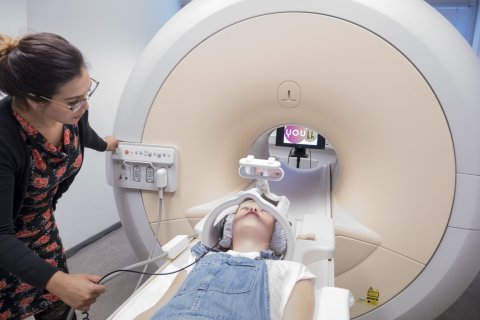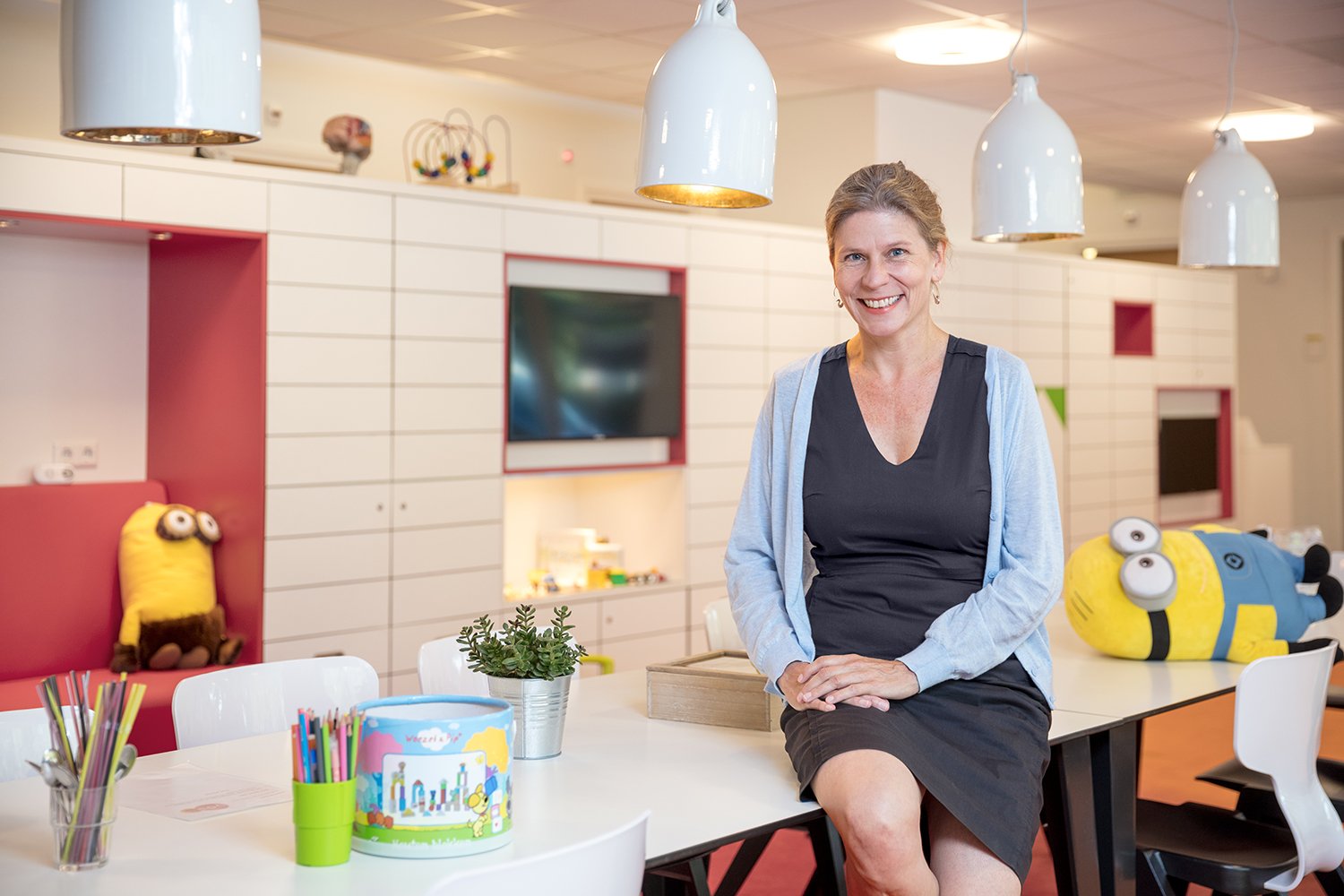Looking to the future with Dynamics of Youth
Interview with programme director Chantal Kemner
Within Utrecht University’s research theme Dynamics of Youth, scientists from all fields of expertise study how young people develop in our rapidly changing society. The programme has recently been extended for a four-year term, and Programme Director Chantal Kemner is looking forward to the future. How is Dynamics of Youth changing along with the equally rapid pace of change in the scientific community?
What is the best way to deal with social problems? According to Chantal Kemner, Professor of Biological Development Psychology, it is to start with the children. “Dynamics of youth is about working together in order to better understand child development. It’s about how people become who they are, and why they do what they do. The children growing up today will eventually help shape our world in 10 or 20 years, so we are investing in the future. But children are also a vulnerable group, and we as a society must ensure that they can grow up healthy in mind and body.
In order to complete the puzzle, one needs input from all corners of the university.
The theme also offers endless opportunities for scientists: ‘How does a child grow up, and what does that entail? The interplay of all of the various factors that affect child development is unbelievably fascinating, and has connections to every other field of study.” In order to complete the puzzle, one needs input from all corners of the university: “There is a reason why we are the broadest strategic theme. Every faculty has someone with vital knowledge or skills to contribute.”
Utrecht differentiates itself from other universities with its broad perspective: “Our youth research not only focuses on child development and developmental psychology; we also have a strong biological aspect as well. For example, we conduct neurological research at the molecular level: how do nerve cells grow? At the Faculty of Humanities, researchers study language and identity. Geoscientists focus on the environment in which children grow up, and law scholars examine legislation, such as child custody arrangements in the event of a divorce. UMC Utrecht is also heavily involved, such as with its research into premature babies (Dutch). And at the Faculty of Veterinary Medicine, researchers study the importance of play.’
From microscope to telescope

It is necessary to work with scientists from different fields in order to find answers: “Often, your research focuses on a specific question, such as: when is the best time to start teaching children to read? To find out, you first have to know when the child’s brain is receptive to it. And that in turn is based on the growth of nerve cells. As a result, several different researchers form a chain that brings them to the original question of how to organise reading education. That’s a huge step for someone studying brain cells on their own.”
And then there is the link with society as a whole: “In theory, scientists could work together just fine without concerning themselves about the outside world. But we can no longer afford to say: I’m just going to do my own thing. At the very least, you have to explain how your research will contribute to society. Society invests in us, so we have to pay them back.”

Every one of Utrecht University’s strategic themes is currently developing one or more ‘hubs’: a central point and breeding ground for innovative and interdisciplinary research, with collaboration between knowledge institutions, social organisations and businesses. Within Dynamics of Youth, research teams composed of scientists from a variety of fields work together with social partners to develop six concrete projects around interdisciplinary themes for the Child Expertise Center. Our research over the coming years will focus on that.
That corresponds with the vision of Rector Magnificus Bert van der Zwaan, who recently published the book Haalt de universiteit 2040? (Will the university make it to 2040?). In it, he states that the university increasingly needs to be both for and in society. Social relevance is becoming more important, and universities will have to dare to play a leading role in social debates.
Obstacles on the pioneer path

In addition to social impact, the need to differentiate ourselves is another reason why Utrecht has chosen four strategic themes. Kemner: “We can best invest in areas we’re already good at. If you work together on subjects for which you already have plenty of knowledge, then it has an accelerating effect.” It may seem logical to work this way, but experience shows that it will require a major cultural shift in the academic world: “It’s a difficult process. Especially because of the focus on individual excellence over the past few decades. When you collaborate, you work based on the strength of the group as a whole, and that requires a completely different attitude from researchers.”
Kemner is a strong advocate of collaboration between fields of expertise, but she also acknowledges the obstacles: “If you work with someone with a different manner of working, then you sometimes think: what are you doing? It takes a long time before you understand one another and have developed a common vocabulary. Plus, the research culture is different in each field of expertise. It takes a lot of effort, and the benefits aren’t immediately apparent. And you also encounter practical problems, such as: where will you publish? Many scientific journals only focus on one field of study.”

So how can you convince researchers to take a look on the other side of the fence? “Most scientists are triggered by new ways of thinking. Collaboration outside of your own field of study is interesting, exciting and challenging. The same applies to the use of new techniques. More and more equipment is being used in psychology; big data has become a standard aspect of research life. So you have to understand how it works and become familiar with its limitations. If you want to use multiple techniques, then you can’t do it on your own; you need experts from all of the relevant fields.”
Utrecht University is a pioneer when it comes to interdisciplinary cooperation. The Dynamics of Youth seed money projects are excellent examples of that: “They have brought about some great partnerships between people, so it’s wonderful that Dynamics of Youth has been extended for another four years. That is a strong signal: you have the time, and it is important to invest in this field. That gives us the opportunity to continue working on research infrastructure, such as expanding the lab facilities, so that we can set up something for a longer period.”
Individualism is over

The work method advocated by Dynamics of Youth and the other strategic themes is an important step forwards. Kemner thinks it will increase peoples’ confidence in science: “Here too, individualism comes to the fore. That causes many scientists to make statements individually, or even contradict one another. Which in turn contributes to the idea that ‘science is just an opinion’.”
Kemner advocates setting up more large-scale studies in which scientists can collect large amounts of data together: “I conduct research on autism in children. It is unbelievably difficult to find participants for my studies. But now we work as part of a European consortium, because you can’t find the number of children you need on your own. When we work together, we can solve those kinds of problems. Developing large common data sets and instruments is essential.”

Study programmes can profit from that as well: “Students who want to conduct research in relatively small studies often go to schools to study the children there. Afterwards, a large part of those data are never used again. It’s better to have students use existing data and gain measurement experience in large joint studies like the YOUth cohort study and other large-scale studies. We really have to start thinking about that together.”
It’s exciting, and it’s the future. The university is changing, and we have to do it together.
The winding path forwards

What is it like to stand at the wheel of such a broad and innovative research theme? “What makes it exciting and difficult at the same time, is that the process wasn’t always clear to me. Until recently, we didn’t know if we would be able to go forward, and in what form. We tried to motivate people to participate, but we also had to tell them: I don’t know how it’s going to turn out. That was sometimes complicated.”
Kemner herself has never lacked a clear vision: the idea for the KinderKennisCentrum hub was in her mind from the very beginning. The path to the future may be winding, but it also presents beautiful vistas along the way: “We have a huge luxury position. We can actually do the things that we think are important. We’re building something new in an existing organisation - and it’s unique that we can make many of the important choices ourselves.
Colleagues from all corners of Utrecht University are welcome to join the theme: “We want to expand the teams that are developing projects for the hub. Keep an eye on our website and the monthly newsletter, and come to our meetings to talk about our plans, exchange ideas and meet one another. Join us! It’s exciting, and it’s the future. The university is changing, and we have to do it together.”
DYNAMICS OF YOUTH
Dynamics of Youth is one of the four Strategic Themes of Utrecht University. Dynamics of Youth connects excellent child and youth research from all seven faculties, and looks for the answer to a crucial question for future generations: how can we help our children with their development into well-balanced individuals who can successfully hold their own in a rapidly changing environment?


